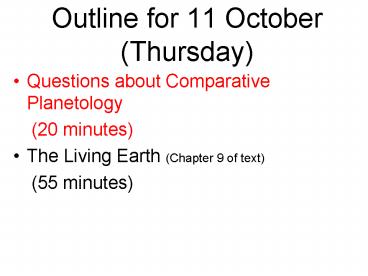Outline for 11 October Thursday - PowerPoint PPT Presentation
1 / 27
Title:
Outline for 11 October Thursday
Description:
Review Questions For Topics Covered in Lecture and Reading ... albedo. atmospheric pressure. aurora (plural aurorae) biosphere. global warming. greenhouse effect ... – PowerPoint PPT presentation
Number of Views:28
Avg rating:3.0/5.0
Title: Outline for 11 October Thursday
1
Outline for 11 October (Thursday)
- Questions about Comparative Planetology
- (20 minutes)
- The Living Earth (Chapter 9 of text)
- (55 minutes)
2
Why are craters circular
- if asteroids can strike the surface at angles?
- http//deepimpact.jpl.nasa.gov/science/cratering.h
tml
3
Review Questions For Topics Covered in Lecture
and Reading
- Do all the planets orbit the Sun in the same
direction? Are all of the orbits circular? - What are the characteristics of a terrestrial
planet? - What are the characteristics of a Jovian planet?
- In what ways does Pluto not fit the usual
classification of either terrestrial or Jovian
planets? - What is meant by the average density of a planet?
What does the average density of a planet tell
us? - In what ways are the largest satellites similar
to the terrestrial planets? In what ways are
they different? - The absorption lines in the spectrum of a planet
or satellite do not necessarily indicate the
composition of the planet or satellites
atmosphere. Why not. - Why are hydrogen and helium abundant in the
atmospheres of the Jovian planets but present in
only small amounts in the Earths atmosphere? - What is an asteroid? What is a comet? In what
ways are these minor members of the solar system
like or unlike the planets?
4
Review Questions For Topics Covered in Lecture
and Reading
- What are the asteroid belt and the Kuiper belt?
Where are they located? How do the objects found
in these two regions compare? - What is the one piece of evidence that impact
craters are actually caused by impacts? - What is the relationship between the extent to
which a planet or satellite is cratered and the
amount of geologic activity on that planet or
satellite? - How do we know that the surface of Venus is older
than the Earths surface but younger than the
Moons surface? - Why do smaller worlds retain less of their
internal heat? - How does the size of a terrestrial planet
influence the amount of catering on the planets
surface? - How is the magnetic field of a planet different
from that of a bar magnet? Why is a large planet
more likely to have a magnetic field than a small
planet?
5
Outline for 11 October (Tuesday)
- Questions about Comparative Planetology
- The Living Earth
- (Chapter 9 of text)
6
Key Words
- northern and southern lights
- outgassing
- ozone
- ozone layer
- Van Allen Radiation belts
- albedo
- atmospheric pressure
- aurora (plural aurorae)
- biosphere
- global warming
- greenhouse effect
- greenhouse gas
- solar wind
- plasma
- magnetosphere
7
Guiding Questions
- What is the greenhouse effect? How does it affect
the average temperature of the Earth? - How does our planets magnetic field protect life
on Earth? - Why is Earth the only planet with an oxygen-rich
atmosphere? - What are global warming and the ozone hole? Why
should they concern us?
8
Protective Shields
- Atmosphere
- Magnetic field
9
(No Transcript)
10
On Predictions
11
Atmosphere
12
Energy Balance
13
Energy Balance
14
The Greenhouse effect
- Two usages
- An effect that occurs on a a planet with and
Earth-like atmosphere - An enhancement of the above effect due to human
activity
15
The Greenhouse effect
16
The Greenhouse effect
17
Group Questions
- Make an argument to justify the statement The
temperature trend is due to chance. - Make an argument to justify the statement The
temperature trend is not due to chance. - Name three pieces of information that would help
justify/refute each of the statements. - Due to chance
- Not due to chance
18
Protective Shields
- Atmosphere
- Magnetic field
19
The Solar Wind
20
The Solar Wind
- A plasma is created by ionizing atoms
- Besides sending out photons, the sun is the
source of the solar wind a plasma traveling at
400 km/s - When the plasma gets near Earth, the charged
particles are influenced by Earths (internal)
magnetic field. - The path a particle takes is complicated ions
and electrons tend to rotate around magnetic
field lines - www.spaceweathercenter.org/our_protective_shield/0
1/minigolf.html
21
The Magnetosphere
- The solar wind distorts Earths dipole magnetic
field to form the magnetosphere
22
Formation of the Magnetosphere
- http//meted.ucar.edu/hao/aurora/squish.htm
23
The Magnetosphere
24
Van Allen Radiation Belts
25
Aurora
- Some charged particles from the solar wind are
trapped in two huge, doughnut-shaped rings called
the Van Allen belts
26
Review Questions
- If the Earth did not have a magnetic field, do
you think aurorae would be more common or less
common than they are today? - Carbon dioxide and ozone each make up only a
fraction of a percent of our atmosphere. Why,
then, should we be concerned about small
increases or decreases in the atmospheric
abundance of these gasses? - What are three justifications for global warming?
- What are three rebuttals for global warming?
27
Review Questions
- What is the greenhouse effect?
- What is the solar wind?































